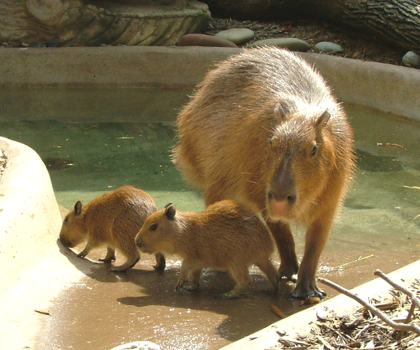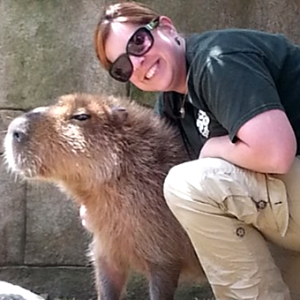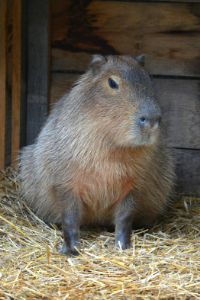If you are a frequent zoo visitor, you are probably familiar with the animal residents of your Akron Zoo. You may even know some of them by name, like Tamarr and Mandisa, two of our lions who have been stealing the spotlight in Pride of Africa! However, it may be unclear to you why occasionally zoos send their beloved animals to other accredited facilities, or stranger yet, why they suddenly house new animal residents of a species they already have.
 Many of these changes are made based on Species Survival Plan recommendations from the Association of Zoo and Aquariums (AZA) Taxon Advisory Groups (TAG). There are almost 250 AZA accredited zoos and aquariums who monitor nearly 500 Species Survival Plans (SSPs) for species currently in human care. The goal of each plan is to ensure the future population will be healthy and diverse.
Many of these changes are made based on Species Survival Plan recommendations from the Association of Zoo and Aquariums (AZA) Taxon Advisory Groups (TAG). There are almost 250 AZA accredited zoos and aquariums who monitor nearly 500 Species Survival Plans (SSPs) for species currently in human care. The goal of each plan is to ensure the future population will be healthy and diverse.
Your Akron Zoo is involved in several SSPs. One such SSP is the Capybara SSP. This plan is lower priority since capybaras have a thriving population in their natural habitat, but the population in human care is not quite where it needs to be to maintain healthy genetic diversity for the future. Shelley Orloski, the Akron Zoo’s volunteer manager, is the current program manager for the Capybara SSP. In fact, Shelley is the only member of the Capybara SSP. As you can imagine, she does a lot to keep the program running smoothly.
“I began as the studbook keeper in 2006,” says Orloski. “My job was to track and sort all of the data on individual capybaras: who they are, who their parents are, where they are living and any animal-specific characteristics such as transponders or medical histories.”
 A year later Orloski was asked to be the program leader. Her role is now to analyze the data and make a breeding and transfer plan. Every three years she sends a survey to all known AZA facilities with capybaras. The survey gathers data about how many capybaras each zoo has, how many they want, whether they are expanding or building a new habitat, if they are willing to house more capybaras or if they are phasing them out in the future. Once she receives the results of the survey, Orloski works with the Population Management Center (PMC), a part of Lincoln Park Zoo, to determine what the population as a whole is doing and if they are meeting their goals.
A year later Orloski was asked to be the program leader. Her role is now to analyze the data and make a breeding and transfer plan. Every three years she sends a survey to all known AZA facilities with capybaras. The survey gathers data about how many capybaras each zoo has, how many they want, whether they are expanding or building a new habitat, if they are willing to house more capybaras or if they are phasing them out in the future. Once she receives the results of the survey, Orloski works with the Population Management Center (PMC), a part of Lincoln Park Zoo, to determine what the population as a whole is doing and if they are meeting their goals.
The last breeding and transfer plan was completed in 2017, so the next plan will go into effect next year. Currently there are 170 capybaras in AZA facilities: 84 girls, 78 boys, and 8 who have not yet been sexed. The goal is to have a population of 200. Records are kept on the outcomes of each breeding recommendation. This information is used to place offspring during the next breeding and transfer plan.
 Often people do the best they can, but not everyone has the funding or the space to follow recommendations. For example, a zoo must have the ability to house offspring for at least two years in order to allow time for them to be placed, and not all zoos have the space or money for a new short-term resident. There may also be some individuals in the species who are ideal for breeding on paper, but in reality should not breed. Atlantis, your Akron Zoo’s capybara, is one of the individuals who no longer participates in her own SSP. She has made it clear that she prefers not to share her habitat with other capybaras.
Often people do the best they can, but not everyone has the funding or the space to follow recommendations. For example, a zoo must have the ability to house offspring for at least two years in order to allow time for them to be placed, and not all zoos have the space or money for a new short-term resident. There may also be some individuals in the species who are ideal for breeding on paper, but in reality should not breed. Atlantis, your Akron Zoo’s capybara, is one of the individuals who no longer participates in her own SSP. She has made it clear that she prefers not to share her habitat with other capybaras.
Though this is a long and complicated process, Orloski still loves her role as the SSP program leader. She is even in the process of writing the animal care manual for capybaras, which is in its last round of edits.
“I have enjoyed working with the Capybara SSP because every day is an adventure,” says Orloski. “I never know what kind of questions I will receive regarding them.”
Next time you stop by your Akron Zoo, don’t forget to say hello to Atlantis! And check out our endangered species page to learn about the other SSPs we are involved in!
By Erica Rymer, Events & Marketing Specialist. Published July 9, 2019.
